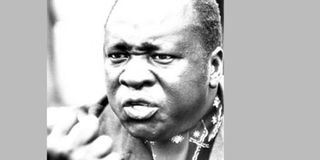Prime
Amin names smart Cabinet with one soldier, no women

As Head of State and Minister of Defence, Idi Amin Dada focused on strengthening his government militarily, recruiting 10,000 men to the army. Courtesy Photo
What you need to know:
Playing to the gallery. Amin gave 18 reasons for the overthrow of Apolo Milton Obote’s government but within weeks he was committing some of the very mistakes and massacres he accused the ousted leader of.
18 points
• Detention without trial
•Continuation of the state of emergency
• Lack of freedom to air political views
• Attacks by armed robbers
• The proposals for a National Service
• Widespread corruption in high places
• Failure to organise elections
• Economic policies that had impoverished the people
• High taxes
• Low crop prices compared to cost of food and education
• Isolating Uganda from East Africa by repatriating Kenyans and refusing to accept other currencies
• Creation of a wealthy class of leaders
•Failure of the Defence Council to meet
• Creation of a second army from Akokoro County where Obote hailed from
• The Lango Development Plan to give preference to people from Akokoro
• Dividing the army by giving top positions to Langi
• Using the cabinet to divide the army through robbery
• All the matters above were leading to bloodshed
Amin and his henchmen – they were yet to earn that dreaded name – gave 18 reasons for overthrowing the Obote regime, including the need to end detention without trial and protect other civil liberties.
The new regime had two immediate areas of concern: acquiring domestic and foreign political legitimacy, as well as consolidating the military constituency that made up the regime’s core.
The release of political prisoners, the return of Kabaka Mutesa’s remains, and the ensuing euphoria gave Amin early domestic political capital.
He invested this in two ways: First he issued an 18-point programme, giving reasons for the coup, and promising early elections to return the country to civilian rule. (See panel for the 18 points).
Amin then named an 18-man Cabinet that included some of the country’s best political brains and respected leaders. None of the ministers was a woman. Apart from Amin, only one other minister, Lt. Col. Obitre-Gama, was from the military.
Many of the new ministers had been permanent secretaries and Amin described them as a ‘cabinet of talents’. Chief Justice Sir Dermont Sheridan swore in the new ministers at Kololo Airstrip on February 2, 1971 and there were celebrations across the country on what had been declared a public holiday.
Several diplomats, dignitaries and ranking civil servants attended the function where Archbishop Eric Sabiti of the Anglican Church of Uganda, Archbishop Emmanuel Nsubuga of the Catholic Church, later to become Cardinal, and Sheikh Ali Kulumba led prayers.
The guests were later hosted to a state banquet at State House Entebbe, before the new cabinet met for the first time two days later in a meeting that is reported to have lasted 11 hours.
On February 21, the Uganda Army promoted Maj. Gen. Idi Amin to the rank of general, skipping that of lieutenant general.
One anonymous writer notes: “The army also ‘suggested’ that he should be the new president of the second Republic. Amin said he would consult his Cabinet. When he did, the Cabinet unanimously accepted the ‘suggestion’. It was agreed that Idi Amin Dada would be President for at least five years as the country prepared for general elections.”
If winning political legitimacy was easy, consolidating the military was anything but.
An estimated 600 soldiers, mostly Obote loyalists, had fled the country after Amin’s coup in 1971 and had set up camps in Tanzania. Another batch, estimated at around 1,000, were in southern Sudan. Together, these two forces started preparations for an armed invasion of Uganda to overthrow the Amin regime.
Prof. Mahmood Mamdani notes that this group represented a narrow class interest of the bureaucratic petty bourgeoisie, which could only retake power through an invasion.
“Its principle was not to unite with the people and bring their interests to the fore, but to champion its own interests and hope the people would remain passive bystanders,” he wrote in his book, Politics of Class Formation in Uganda.
“It should not be the least surprising, then, that in its hour of need it turned, not to the people of Uganda, but to friendly ruling classes elsewhere. Nor should it be surprising that as its instrument it sought to train another professional mercenary armed force and invade.”
This, Mamdani notes, influenced Amin’s policy in two ways: Externally, he sought to build alliances, such as with Sudan, on top of strengthening his existing alliances with the British and the Israelis.
Internally, Amin sought to strengthen himself militarily. On the one hand, he launched a major recruitment drive which attracted 10,000 men, mostly loyalists, in three months, doubling the size of the army in the process.
Mamdani notes: “The core of the new recruits were some 4,000 Sudanese ex-Anyanya fighters, along with a sprinkling of former Zairian freedom fighters. The bulk of the remainder came from Amin’s own West Nile District; 40 per cent of these were Muslims.
“In sum, the new army was primarily a mercenary force. The greatest care was taken to ensure that the condition of their survival was the continuation of Amin’s rule.” This recruitment drive was following earlier attempts by Obote to populate the army with his own tribesmen and isolate Amin. Thus the army now had two factions; the remnants of the pro-Obote faction, and the new pro-Amin recruits.
This was a contradiction that had to be resolved. It was also a contradiction that gave very early glimpses of who Idi Amin Dada really was; a not-so-gentle giant whose primary tool of political persuasion and control was violence.
Continues tomorrow.




